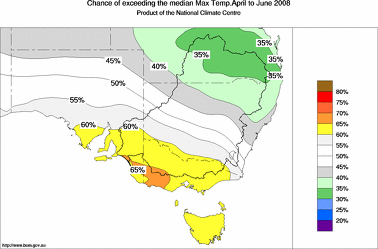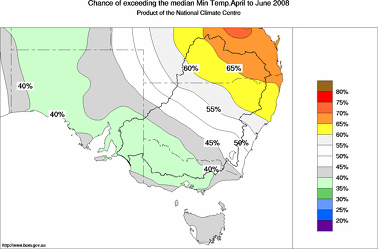|
The pattern of seasonal maximum temperature odds across southeast Australia is a
result of the combined effects from above average temperatures in the southeast
Indian Ocean, and the cooler than average temperatures in the equatorial Pacific
(La Niña).
Averaged over April to June, the chances are between 60 and 70% for above-normal
maximum temperatures in Tasmania, Victoria and southern SA (see map).
So for every ten years with ocean patterns like the current, about six or seven
June quarters are expected to be warmer than average over these parts of the country, with about
three or four being cooler.
In contrast, above-normal maximum temperatures have only a 30 to 40% chance of
occurring over the northeast quarter of NSW. This is consistent with the rain
outlook which favours above average falls in this region.
Outlook confidence is related to how consistently the Pacific and Indian
Oceans affect Australian temperatures. During the June quarter, history shows this
effect on maximum temperatures to be moderately consistent over much of eastern
and northern NSW, the northern two-thirds of Tasmania and parts of far western
and northern SA (see background information). However, confidence levels are low in most
of SA and Victoria, so this outlook should be used with caution in those areas.
The minimum temperature outlook for the June quarter is also a mixed pattern, with
a moderate shift in the odds favouring warmer nights in northeast NSW, while cooler
nights are favoured in a band from northwest SA to Victoria (see map).
History shows the oceans' effect on minimum temperatures in the April to June period
to be moderately consistent over most of NSW, Victoria and the southern half of
SA. In Tasmania and northern SA the effect is only weakly or very weakly consistent.
| 










